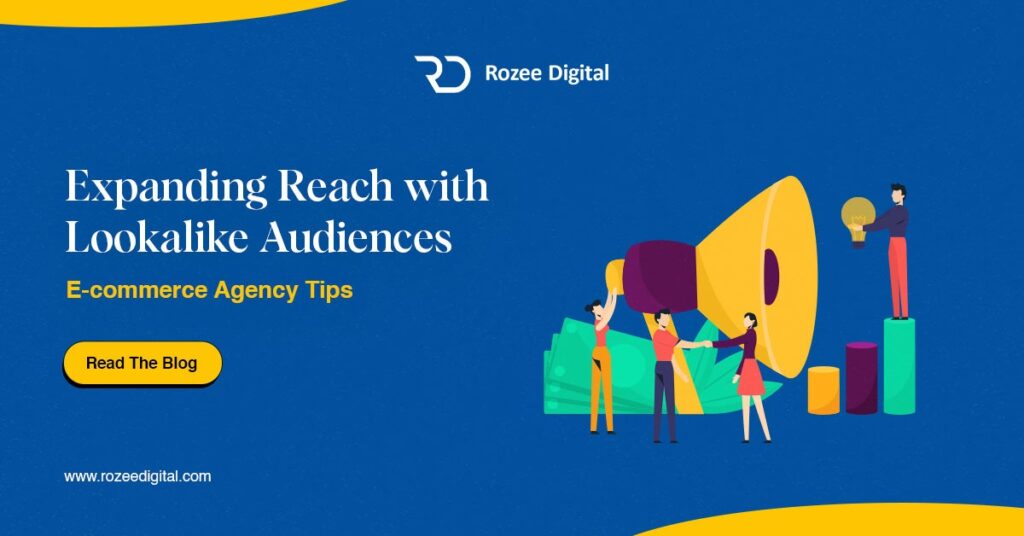For nearly a decade, lookalike audience targeting has been a crucial marketing tool for brands and organizations aiming to expand their reach and boost sales. Marketers have traditionally utilized audience targeting to align their prospective client lists with the behaviors and demographics of their top customers.
Even before the advent of digital marketing, identifying, tracking, and engaging high-value audiences was a priority for businesses of all types, from car dealerships to beauty brands. Today, with the widespread availability of AI-driven marketing tools, companies of all sizes can leverage the most advanced lookalike audience targeting technology.
Lookalike marketing is a highly effective strategy used for leveraging ways to expand your reach and attract new customers for growth. This powerful tool, provided by platforms like Facebook and Google, allows e-commerce businesses to target new potential customers who resemble their existing ones. Here, we delve into what lookalike audiences are, how they work, and provide essential tips for e-commerce agencies to maximize their effectiveness.
What are Lookalike Audiences?
A lookalike audience is basically an audience consisting of users who resemble other users. Advertisers create lookalike audiences using sources such as customer lists from your CRM, website traffic tracked by a Meta pixel, or video views.
What does “look like” exactly mean in this context? For social media platforms, it means identifying users with similar interests and online behaviors to target with ads.
The goal is to help businesses reach an audience that is most likely to engage and convert. Lookalike audiences are a sophisticated targeting option that uses data from your existing customers to find similar potential customers. Lookalike audience targeting is one of the most powerful tools in e-commerce for distinguishing your brand from the competition. By analyzing behaviors, interests, and demographic information, these platforms create a new audience that mirrors your best customers. This method significantly enhances the likelihood of reaching individuals who are more likely to engage with your brand and make a purchase.
In 2013, Facebook launched what is considered the industry’s first lookalike marketing platform, enabling the tracking of potential customers based on shared interests and behaviors with existing customers. Since then, many other platforms have incorporated similar services into their marketing capabilities.
Evidence suggests that look alike audiences can significantly enhance a company’s competitive edge. According to McKinsey & Company, integrating behavioral insights into marketing strategies increased sales growth by 85 percent compared to similar companies not using lookalike targeting. Utilizing customer data in this manner also allowed these companies to outperform competitors by more than 25 percent in gross margin.
Seven Types of Lookalike Audiences
1. Custom Audience: Based on the advertiser’s own data, such as website visitors, app activity, or email subscribers. Targets users who have shown interest in the brand.
Example: A clothing retailer targets users who visited its website in the past 30 days with ads for its latest collection.
2. Seed Audience: A specific group of users provided by the advertiser to create a lookalike audience. The platform analyzes this group to find similar users.
Example: A travel agency uses its most loyal customers as a seed audience to target users with similar demographics, interests, and travel preferences.
3. Current Customer List: Based on the advertiser’s existing customer list, identifying similar users.
Example: An online bookstore targets users with similar reading preferences and purchasing behaviors as its current customers.
4. App Users: Derived from data collected from the advertiser’s mobile app, identifying similar users.
Example: A fitness app targets users with similar fitness goals and interests as those who consistently use the app.
5. Email List Subscribers: Based on the advertiser’s email subscriber list, identifying similar users likely to buy.
Example: An online beauty retailer targets users with similar beauty preferences and purchasing behaviors as its email subscribers.
6. Single-Source Audiences: Created from a single source, such as website visitors or app users.
Example: A software company targets users with similar browsing behaviors and interests as its website visitors.
7. Interest-Based Lookalike Audience: Based on specific interests or topics identified by social media platforms.
Example: A gaming company targets users with similar interests in specific game genres as its current visitors.
By leveraging these types of lookalike audiences, advertisers can effectively reach a larger pool of potential customers who are more likely to convert.
Benefits of Using Lookalike Audiences
Let’s explore some of the additional benefits of using lookalike audiences in your ad campaigns:
1. Increasing the Reach of Your Marketing Campaigns
Lookalike audiences enable advertisers to extend their reach beyond their existing customer base. By targeting users with similar characteristics and behaviors to their current audience, advertisers can tap into a larger pool of potential customers, expanding their reach and increasing brand exposure.
2. Improving Ad Targeting and Relevancy
Lookalike audiences are created based on the characteristics and behaviors of your best customers. This means users within the lookalike audience are more likely to be interested in the advertiser’s products or services. By targeting a more relevant audience, advertisers can increase the chances of generating engagement, conversions, and sales.
3. Enhancing Engagement and Conversion Rates
Since lookalike audiences share similar attributes with the advertiser’s existing audience, they’re more likely to be genuinely interested in the products or services offered. This increases the likelihood of leads or sales, resulting in higher conversion rates and a better return on investment (ROI) for advertisers.
4. Maximizing Return on Ad Spend (ROAS)
Traditional targeting methods often rely on broad demographic or interest-based targeting, which can waste ad spend on disinterested users. Lookalike audiences, on the other hand, focus on relevant users, optimizing ad spend and reducing waste.
5. Building Brand Awareness and Loyalty
The audiences targeted will see the ads, and even if they don’t click, they’ll begin to recognize the logo and brand, boosting awareness. This increases brand awareness and makes the advertiser’s products or services more familiar to users.
6. Improving Ad Performance
Targeting a more relevant audience can lead to improved ad performance metrics. Users within the lookalike audience are likely to engage with the ads, resulting in higher click-through rates (CTRs), lower bounce rates, and longer session durations. This can ultimately lead to better ad performance and lookalike campaign success.
7. Allowing Data-Driven Decision Making
Lookalike audiences are created using data analysis and algorithms. This data-driven approach ensures audience targeting is based on objective criteria rather than subjective assumptions. Advertisers can leverage the platform’s data and algorithms to identify users with the highest potential for conversion, resulting in more effective targeting.
8. Scaling Campaigns as Needed
Lookalike audiences can be scaled up or down based on the desired similarity percentage. Advertisers can choose to target a smaller, more closely matched audience or a larger, broader audience. This flexibility allows advertisers to adjust their targeting strategy based on their campaign goals and budget.
Secret Tips for E-commerce Agencies to maximize Lookalike Audience Targeting
1. Start with a High-Quality Source Audience
The foundation of an effective lookalike campaign is a high-quality source audience. Use data from your best customers – those who have made repeat purchases, have high engagement rates, or have a high lifetime value. The more robust and accurate your source audience, the better your lookalike audience will be.
2. Construct Lookalike Audience Seeds
Identify common behaviors, demographics, and interests of your ideal target audience for a particular product or campaign. Lookalike seeds should be specific enough to create a targeted audience type, typically consisting of 1,000 to 50,000 users. Data can be collected through:
- Conversion Data: Compare prospective customers with those who have already completed purchases or engaged with your business.
- CRM Data: Use existing customer information, such as email, physical addresses, and purchase history, to define lookalike audiences.
- Engagement Seeds: Base seeds on online activity like page views, clicks, and product views.
3. Get Familiar with Behavioral Targeting Segments
Segmentation allows you to create multiple look alike audiences tailored to different aspects of your business. For instance, you might have a segment for high-value customers, another for frequent buyers, and another for seasonal shoppers. This approach helps you target more specific groups, improving the relevance of your ads.
Also, it is very important to identify the behavioral targeting segments most valuable to your e-commerce business. Create segments representing shared demographics and behaviors. For example, different segments for frequent buyers of high-end products versus budget shoppers. Finding the right balance between size and efficiency in your segments will depend on your company goals.
4. Connect Lookalike Behaviors with Marketing Goals
Align the behaviors of your audience segments with your look alike marketing objectives. For example, if mobile users show higher engagement and purchase rates, direct your marketing dollars toward them to achieve specific goals, such as clearing out seasonal inventory.
5. Target and Retarget
Use lookalike targeting to find new customers and inform retargeting campaigns. Retarget users who have shown engagement or intent but did not convert, by further segmenting them by demographic, location, and behavior. For instance, target users who abandoned their shopping carts with personalized promotions.
6. Adjust the Similarity Threshold
Platforms like Facebook offer different levels of similarity when creating lookalike audiences. A 1% lookalike audience closely matches your source audience, while a 10% lookalike audience is broader but less similar. Start with a smaller percentage to target the most similar users, then expand to larger percentages as you optimize your lookalike campaigns.
7. Switch Up Your Platforms
Utilize different platforms for lookalike audience targeting:
- Facebook: Use names, email addresses, phone numbers, location, age, and gender to define lookalike audiences.
- Google: Create a “custom affinity audience” with Google Analytics and Google Ads to target users likely interested in your product or service. Dynamic prospecting uses AI to determine valuable customer behaviors.
- LinkedIn: Leverage LinkedIn’s Matched Audience segmentation to create lookalike audiences up to 15 times larger than your original audience size.
8. Expand Your Lookalike Audience with a Smart Digital Platform
Invest in an intelligent digital ad platform to manage customer data and audience segments across multiple platforms. AdRoll, for instance, uses pixel data and audience segments to match your ideal customer behaviors and demographics to its database of 1.2 billion digital profiles. This helps improve marketing ROI and reach a new crop of engaged consumers.
Leveraging Social Media Platforms
- Lookalike audience Instagram: Instagram’s visual appeal can help you effectively target and engage with lookalike audiences who are visually driven.
- Twitter lookalike audiences: Twitter allows you to reach users who have similar interests and behaviors to your best customers.
- TikTok lookalike audiences: With TikTok growing popularity, using lookalike targeting on this platform can help you tap into a younger, highly engaged audience.
9. Test and Optimize Your Campaigns
As with any marketing strategy, testing and optimization are key to success. Experiment with different ad creatives, messages, and offers to see what resonates best with your lookalike audiences. Use A/B testing to compare performance and continuously refine your approach for better results.
10. Integrate with Other Marketing Strategies
Lookalike targeting works best when integrated with a broader marketing strategy. Combine them with retargeting campaigns, email marketing, and content marketing to create a cohesive and comprehensive approach. This integration helps reinforce your brand message and increases the chances of converting potential customers.
Conclusion
Expanding your reach with lookalike audiences can be a game-changer for e-commerce businesses. By leveraging the power of data and sophisticated targeting options, you can find new customers who are likely to be interested in your products, improve your ad performance, and achieve greater marketing efficiency. Implement these tips and watch your e-commerce business grow by reaching the right audience at the right time.Need assistance building a marketing strategy using lookalike audience targeting to nurture your business? Rozee digital loves to help.
FAQs
What information is used to identify similar audiences?
Platforms use data such as purchase history, browsing behavior, demographics, and interests to identify and create lookalike audiences.
How often should I update my source audience?
It’s advisable to update your source audience regularly, ideally every few months, to ensure your lookalike audience reflects your current best customers.
What size should my lookalike audience be?
Start with a smaller percentage (1-2%) for a highly targeted audience and gradually expand (up to 10%) as you optimize your campaigns for broader reach.
Can I create lookalike audiences on multiple platforms?
Yes, platforms like Facebook, Instagram, Twitter, and TikTok all support lookalike audiences. Utilize each platform’s unique strengths to maximize your reach
How can I measure the success of my lookalike campaigns?
Track metrics such as conversion rates, cost per acquisition, and return on ad spend (ROAS) to measure the effectiveness of your lookalike marketing efforts





